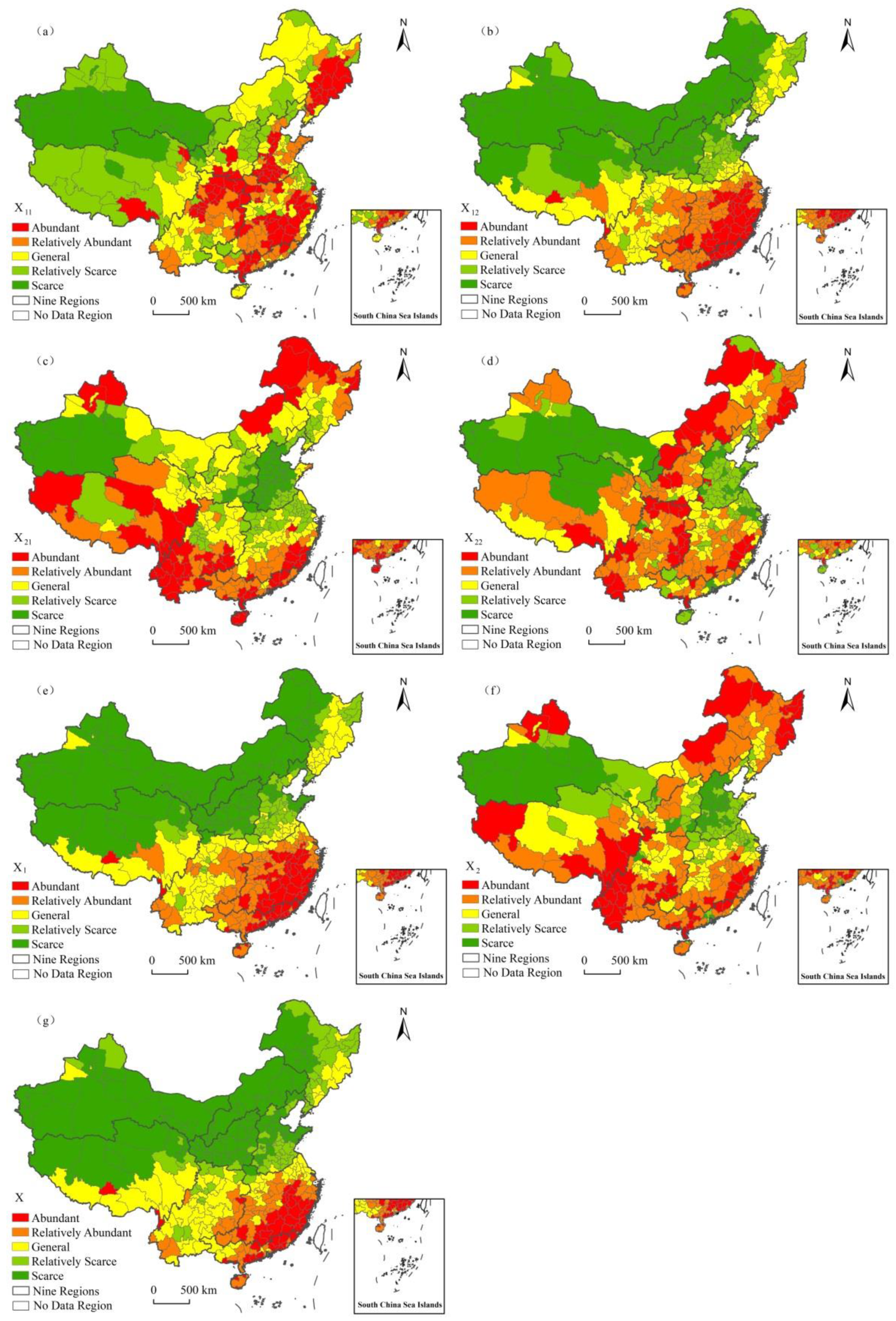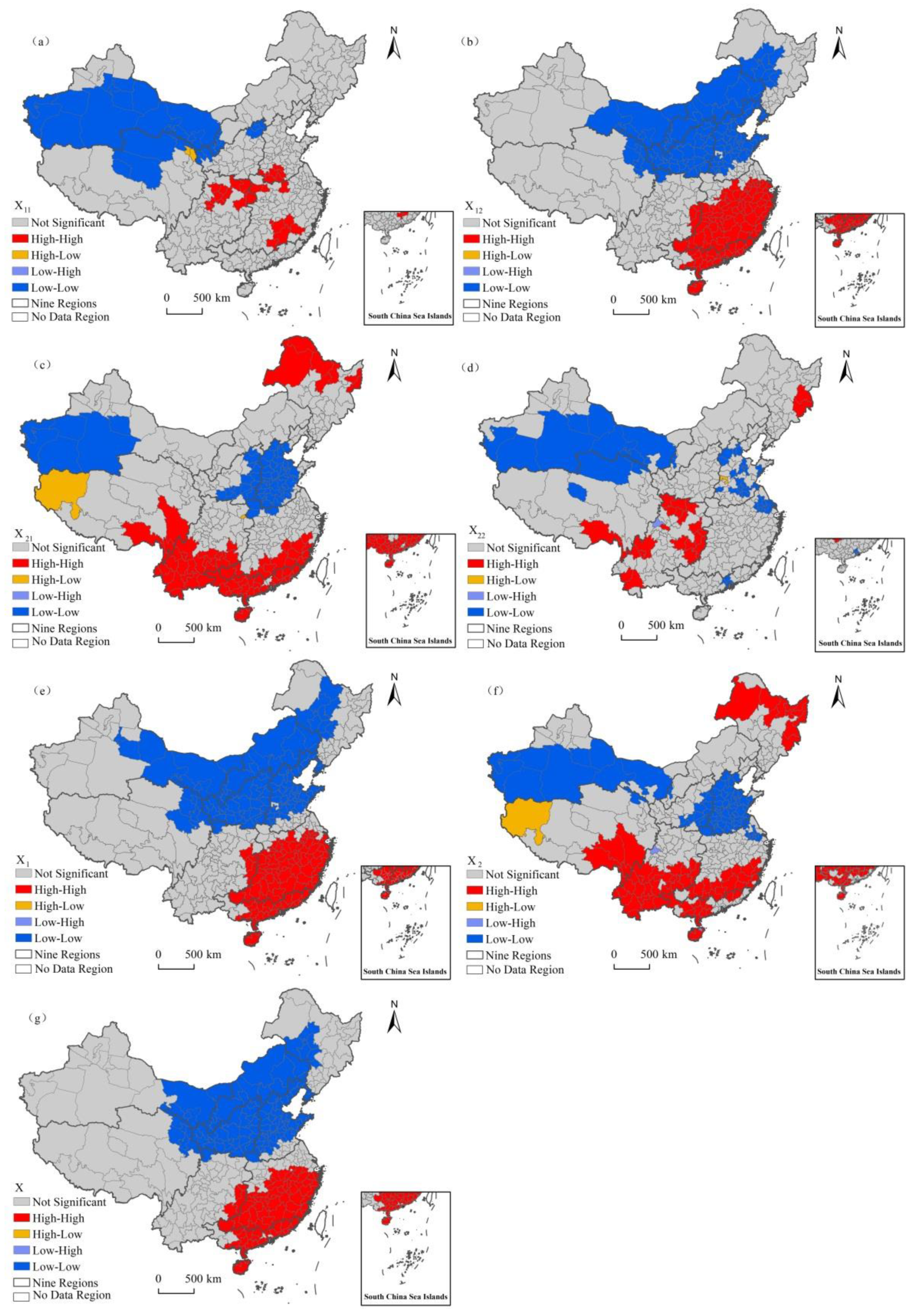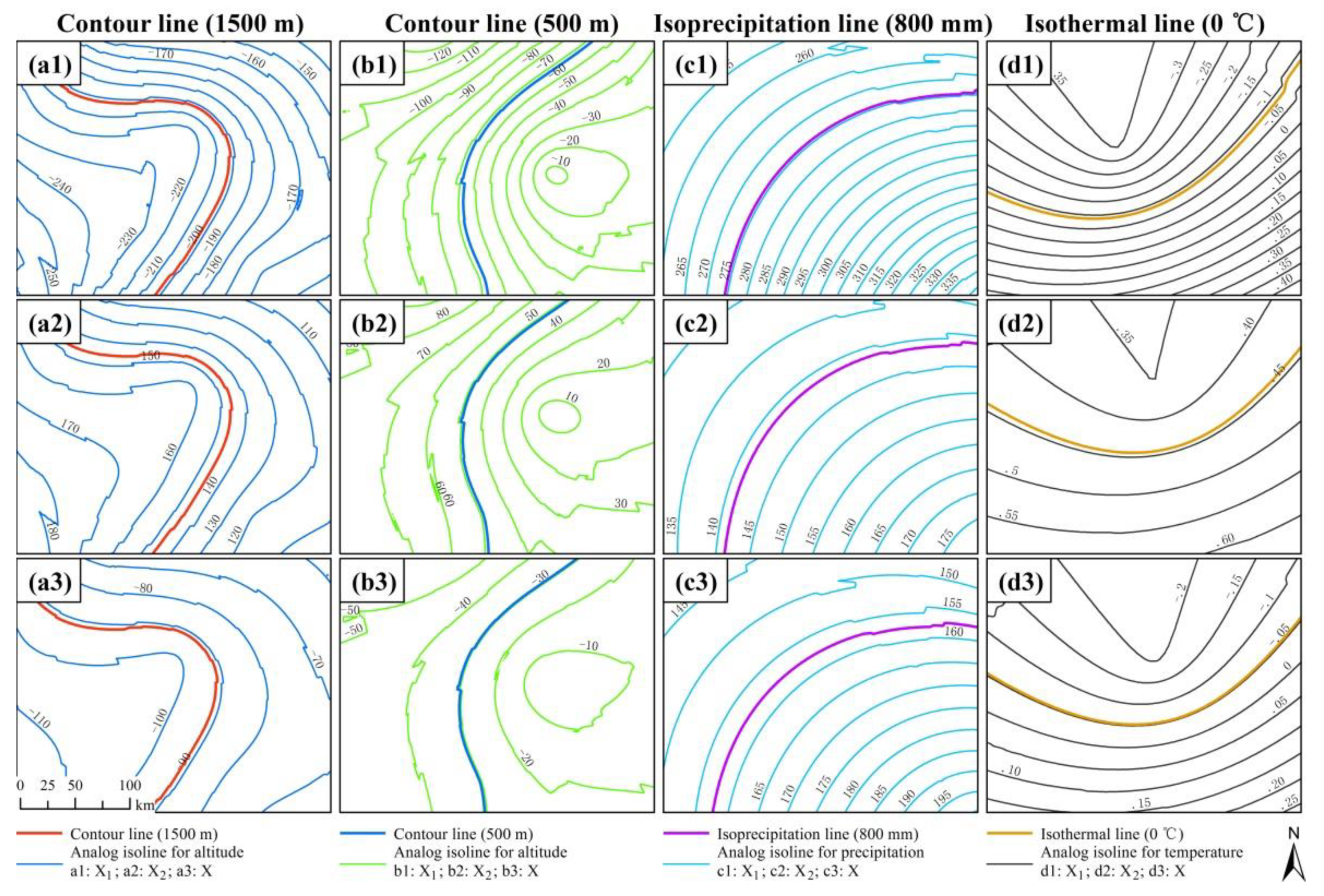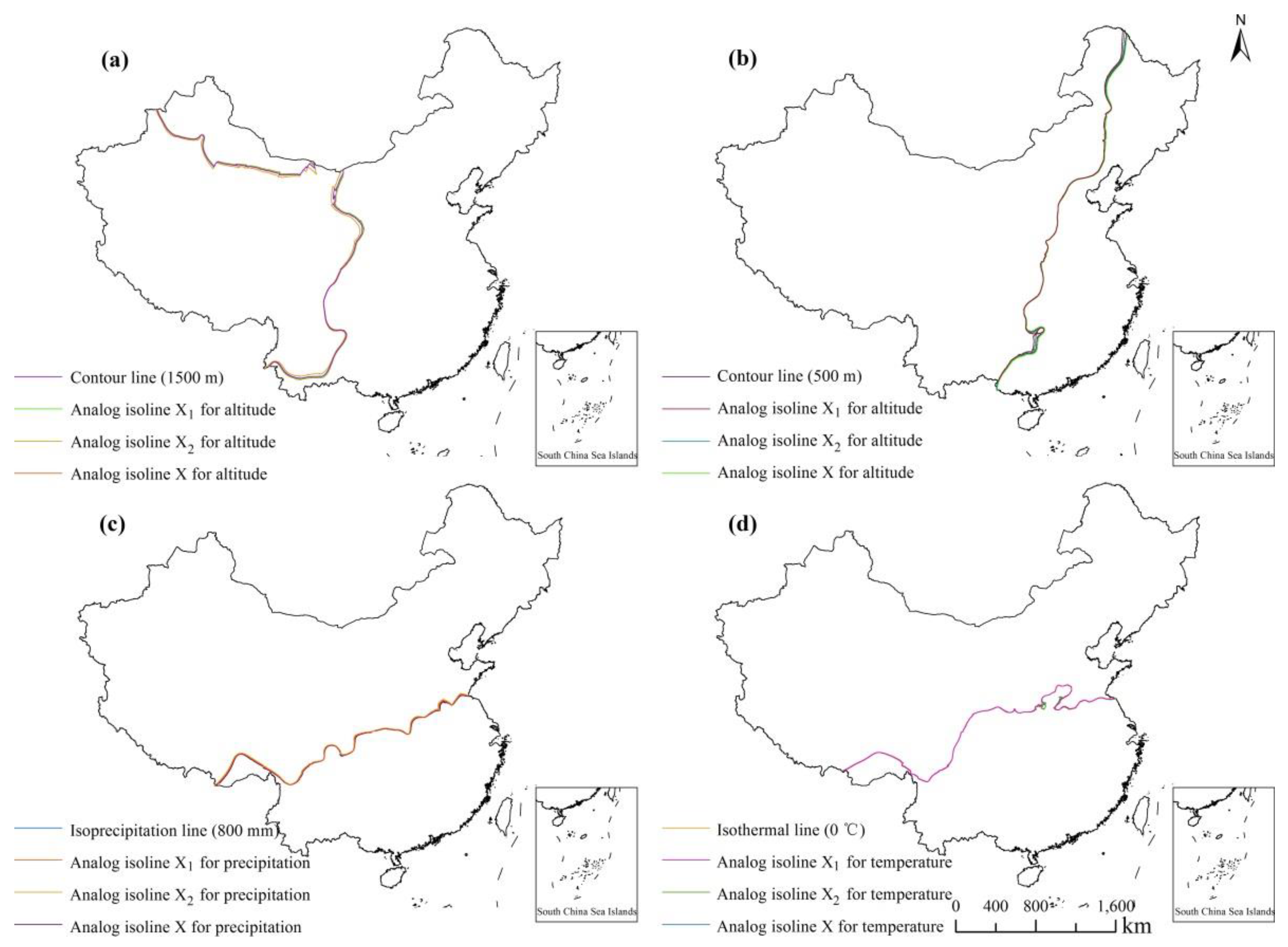Spatial Distribution and Geographical Mechanism of Natural Resources in China under the Orientation of the New Economic Demands
Abstract
1. Introduction
2. Research Ideas and Methods
2.1. Research Ideas
2.2. Research Method
2.2.1. The Spatial Autocorrelation Model
2.2.2. The Line Group Similarity Model
3. Data Sources
4. Results
4.1. Spatial Pattern of Terrestrial Surface Natural Resources in China
4.1.1. Geographical Distribution Characteristics of Natural Resources
4.1.2. Spatial Agglomeration Characteristics of Natural Resources
4.2. Geographical Mechanism of the Spatial Distribution of Natural Resources
4.2.1. Quantitative Relationship between the Endowment of Natural Resources and the Natural Environment
4.2.2. The Spatial Relationship between Natural Resource Endowment and Natural Environment
5. Conclusions and Discussion
5.1. Conclusions
5.2. Discussion
Author Contributions
Funding
Institutional Review Board Statement
Informed Consent Statement
Data Availability Statement
Acknowledgments
Conflicts of Interest
References
- Zalasiewicz, J.; Williams, M.; Steffen, W.; Crutzen, P. The new world of the Anthropocene. Environ. Sci. Technol. 2010, 44, 2228–2231. [Google Scholar] [CrossRef]
- Fan, J.; Jiang, Z.L. Trend of human-economic geography in relation to the Future Earth initiative for systemic solutions of regional sustainable development. Prog. Geogr. 2015, 34, 1–9. [Google Scholar]
- Colglazier, W. Sustainable development agenda: 2030. Science 2015, 349, 1048–1050. [Google Scholar] [CrossRef] [PubMed]
- Gjorgievski, V.Z.; Markovska, N.; Pukšec, T.; Duić, N.; Foley, A. Supporting the 2030 agenda for sustainable development: Special issue dedicated to the conference on sustainable development of energy, water and environment systems 2019. Renew. Sustain. Energy Rev. 2021, 143, 110920. [Google Scholar] [CrossRef]
- Emily, G. Preservation and Use of Natural Resources in the Developing World: A Case Study of the Can Gio Biosphere Reserve, Ho Chi Minh City, Vietnam. Occam’s Razor 2011, 1, 17–37. [Google Scholar]
- Motesharrei, S.; Rivas, J.; Kalnay, E.; Asrar, G.R.; Busalacchi, A.J.; Cahalan, R.F.; Cane, M.A.; Colwell, R.R.; Feng, K.S.; Franklin, R.S.; et al. Modeling Sustainability: Population, Inequality, Consumption, and Bidirectional Coupling of the Earth and Human Systems. Natl. Sci. Rev. 2016, 3, 470–494. [Google Scholar] [CrossRef]
- Cumming, G.S. The relevance and resilience of protected areas in the Anthropocene. Anthropocene 2016, 13, 46–56. [Google Scholar] [CrossRef]
- Moore, J.E.; Mascarenhas, A.; Bain, J.; Straus, S.E. Developing a comprehensive definition of sustainability. Implement. Sci. 2017, 12, 1–8. [Google Scholar] [CrossRef]
- Galaz, V.; Biermann, F.; Crona, B.; Loorbach, D.; Folke, C.; Olsson, P.; Nilsson, M.; Allouche, J.; Persson, A.; Reischl, G. Planetary boundaries: Exploring the challenges for global environmental governance. Curr. Opin. Environ. Sustain. 2012, 4, 80–87. [Google Scholar] [CrossRef]
- Griggs, D.; Stafford-Smith, M.; Gaffney, O.; Rockström, J.; Öhman, M.C.; Shyamsundar, P.; Steffen, W.; Glaser, G.; Kanie, N.; Noble, I. Sustainable development goals for people and planet. Nature 2013, 495, 305–307. [Google Scholar] [CrossRef]
- Ringler, C.; Bhaduri, A.; Lawford, R. The nexus across water, energy, land and food (WELF): Potential for improved resource use efficiency? Curr. Opin. Environ. Sustain. 2013, 5, 617–624. [Google Scholar] [CrossRef]
- Daher, B.T.; Mohtar, R.H. Water-energy-food (WEF) Nexus Tool 2.0: Guiding integrative resource planning and decision-making. Water Int. 2015, 40, 748–771. [Google Scholar] [CrossRef]
- Kummu, M.; Guillaume, J.; de Moel, H.; Eisner, S.; Flörke, M.; Porkka, M.; Siebert, S.; Veldkamp, T.I.; Ward, P.J. The world’s road to water scarcity: Shortage and stress in the 20th century and pathways towards sustainability. Sci. Rep. 2016, 6, 1–6. [Google Scholar] [CrossRef]
- Hammond, G.P. Energy, Environment and Sustainable Development: A UK Perspective. Process Saf. Environ. Prot. 2000, 78, 304–323. [Google Scholar] [CrossRef]
- Dincer, I.; Rosen, M.A. A worldwide perspective on energy, environment and sustainable development. Int. J. Energy Res. 2015, 22, 1305–1321. [Google Scholar] [CrossRef]
- Wang, Y.Q.; Huang, X.R.; Gao, L.Y.; Guo, B.Y. Preliminary research on quantitative methods of water resources carrying capacity based on water resources balance sheet. Proc. Int. Assoc. Hydrol. Sci. 2018, 379, 269–277. [Google Scholar] [CrossRef][Green Version]
- Gao, X.X.; Zuo, D.P.; Xu, Z.X.; Cai, S.Y.; Han, X.M. Evaluation of blue and green water resources in the upper Yellow River basin of China. Proc. Int. Assoc. Hydrol. Sci. 2018, 379, 159–167. [Google Scholar] [CrossRef]
- Zang, S.Y.; Huang, X.; Na, X.D.; Sun, L. An Assess approach of land-use to resource-based cities: A case study on land-use process of Daqing region. Int. J. Environ. Sci. Technol. 2015, 12, 3827–3836. [Google Scholar] [CrossRef]
- Wang, S.C. Living with nature in harmony: Water resources problem and countermeasures in China. J. Beijing Norm. Univ. Nat. Sci. 2009, 45, 441–445. [Google Scholar]
- Li, C.G.; Chi, K.G.; Pang, B.; Tang, H.B. Reservoirs operation and water resources utilization coordination in Hongshuihe basin. Proc. Int. Assoc. Hydrol. Sci. 2018, 379, 125–129. [Google Scholar] [CrossRef]
- Zhao, R.Q.; Liu, Y.; Tian, M.M.; Ding, M.L.; Cao, L.H.; Zhang, Z.P.; Chuai, X.W.; Xiao, L.G.; Yao, L.G. Impacts of water and land resources exploitation on agricultural carbon emissions: The water-land-energy-carbon nexus. Land Use Policy 2018, 72, 480–492. [Google Scholar] [CrossRef]
- Chu, C.; Ritter, W.; Sun, X.H. Spatial variances of water-energy nexus in China and its implications for provincial resource interdependence. Energy Policy 2019, 125, 487–502. [Google Scholar] [CrossRef]
- Miao, C.L.; Fang, D.B.; Sun, L.Y.; Luo, Q.L. Natural resources utilization efficiency under the influence of green technological innovation. Resour. Conserv. Recycl. 2017, 126, 153–161. [Google Scholar] [CrossRef]
- Wu, S.M.; Li, L.; Li, S.T. Natural resource abundance, natural resource-oriented industry dependence, and economic growth: Evidence from the provincial level in China. Resour. Conserv. Recycl. 2018, 139, 163–171. [Google Scholar] [CrossRef]
- Wang, S.Y.; Tang, X.; Zhang, B.S.; Wang, W.H. Accounting and management of natural resource consumption based on input-output method: A global bibliometric analysis. Front. Energy Res. 2021, 9, 94. [Google Scholar]
- Xu, Z.G.; Zhuo, Y.F.; Liao, R.; Wu, C.F.; Wu, Y.Z.; Li, G. LADM-Based model for natural resource administration in China. ISPRS Int. J. Geo Inf. 2019, 8, 456. [Google Scholar] [CrossRef]
- Li, G.J.; Wang, Y.S.; Li, Y.L. Synergies within the Water-Energy-Food Nexus to Support the Integrated Urban Resources Governance. Water 2019, 11, 2365. [Google Scholar] [CrossRef]
- Li, D.; Hu, S.M. How does technological innovation mediate the relationship between environmental regulation and high-quality economic development? Empirical evidence from China. Sustainability 2021, 13, 2231. [Google Scholar] [CrossRef]
- Huang, X.H.; Cai, B.Q.; Li, Y.L. Evaluation index system and measurement of high-quality development in China. Rev. Cercet. Interv. Soc. 2020, 68, 163–178. [Google Scholar] [CrossRef]
- Deng, Z.Q.; Zhang, Y.; Yu, A.O. The new economy in China: An intercity comparison. Sage Open 2020, 10, 2158244020977870. [Google Scholar] [CrossRef]
- Xie, X.; Li, K.; Liu, Z.Q.; Ai, H.S. Curse or blessing: How does natural resource dependence affect city-level economic development in China? Aust. J. Agric. Resour. Econ. 2021, 65, 413–448. [Google Scholar] [CrossRef]
- Dong, S.; Zhang, K.; Li, P.F.; Tang, C.J.; Zhu, Y.Y. Economic restructuring and spatial response of traditional industrial cities in the new economy: A case study of Xiangtan. Urban Plan. Forum 2017, 8, 33–37. [Google Scholar]
- Pratt, A.C. New media, the new economy and new spaces. Geoforum 2000, 31, 425–436. [Google Scholar] [CrossRef]
- Bathelt, H.; Cohendet, P. The creation of knowledge: Local building, global accessing and economic development-toward an agenda. J. Econ. Geogr. 2014, 14, 1–14. [Google Scholar] [CrossRef]
- David, T.J. Capturing value from knowledge assets: The new economy, markets for know-how, and intangible assets. Calif. Manag. Rev. 1998, 40, 55–79. [Google Scholar]
- Tolentino, P.E. Technological innovation and emerging economy multinationals: The product cycle model revisited. Int. J. Technol. Manag. 2017, 74, 122–129. [Google Scholar] [CrossRef]
- Beyers, W. On the geography of the new economy: Perspectives from the United States. Serv. Ind. J. 2003, 23, 4–26. [Google Scholar] [CrossRef]
- Fernald, J.G.; Jones, C.I. The future of U.S. economic growth. Am. Econ. Rev. 2014, 104, 44–49. [Google Scholar] [CrossRef]
- Hall, J.L. Informing state economic development policy in the new economy: A theoretical foundation and empirical examination of state innovation in the United States. Public Adm. Rev. 2007, 67, 630–645. [Google Scholar] [CrossRef]
- Hansen, W.; Price, J.; Carnevale, A. America and the new economy: How new competitive standards are radically changing American workplaces. ILR Rev. 1993, 1, 421–422. [Google Scholar] [CrossRef]
- Avgandoña, A. The new economy: Ethical issues. J. Bus. Ethics 2003, 1, 3–22. [Google Scholar] [CrossRef]
- Li, X.J.; Li, G.P.; Zeng, G.; Qin, C.L.; Lin, B.Y.; Zhang, W.Z. Economic Geography, 3rd ed.; Higher Education Press: Beijing, China, 2018; pp. 33–57. [Google Scholar]
- Long, H.L.; Liu, Y.Q.; Li, T.T.; Wang, J.; Liu, A.X. A primary study on ecological land use classification. Ecol. Environ. Sci. 2015, 24, 1–7. [Google Scholar]
- Chen, X.S.; Zhang, K.Y. Regional Economics Theory; The Commercial Press: Beijing, China, 2003; pp. 268–381. [Google Scholar]
- Fan, J.; Zhou, K.; Wang, Y.F. Basic points and progress in technical methods of early-warning of the national resource and environmental carrying capacity (V 2016). Prog. Geogr. 2017, 36, 266–276. [Google Scholar]
- Song, C.Q.; Cheng, C.X.; Shi, P.J. Geography complexity: New connotations of geography in the new era. Acta Geogr. Sin. 2018, 73, 1204–1213. [Google Scholar]
- Zhang, X.M.; Luo, S.; Li, X.M.; Li, Z.F.; Fan, Y.; Sun, J.W. Spatio-temporal variation features of air quality in China. Sci. Geogr. Sin. 2020, 40, 190–199. [Google Scholar]
- Liu, T.; Du, Q.Y.; Mao, H.C. Spatial similarity assessment model and its application in line groups. Geomat. Inf. Sci. Wuhan Univ. 2012, 37, 992–995. [Google Scholar]
- Xu, X.G. Study on evaluation and pre–warning of ecological environment in the Yellow River Delta. Acta Ecol. Sin. 1996, 16, 460–468. [Google Scholar]
- Wang, Z. Theoretical Geography, 3rd ed.; Science Press: Beijing, China, 2019; pp. 149–195. [Google Scholar]
- Ge, Q.S.; Zhao, M.C.; Zheng, J.Y.; Fang, X.Q. Study on division of the terrestrial system in China. Acta Geogr. Sin. 2002, 57, 515–522. [Google Scholar]




| The Index | Index Name | Index Meaning | ||
|---|---|---|---|---|
| X | X1 | X11 | Available land resources | The endowment degree of available land resources in a certain region |
| X12 | Available water resources | The endowment degree of available water resources in a certain region | ||
| X2 | X21 | Available environmental resources | The endowment degree of available environmental resources in a certain region | |
| X22 | Available ecological resources | The endowment degree of available ecological resources in a certain region | ||
| Indexes | 1500 m Contour Line | Similarity | 500 m Contour Line | Similarity | 800 m Isoprecipitation Line | Similarity | January 0 °C Isotherm | Similarity |
|---|---|---|---|---|---|---|---|---|
| X1 | −200 | 0.9799 | 70 | 0.9434 | 275 | 0.9992 | −0.1 | 0.9964 |
| X2 | 150 | 0.9045 | 50 | 0.9822 | 140 | 0.9975 | 0.45 | 0.9780 |
| X | 90 | 0.9753 | −30 | 0.9878 | 160 | 0.9922 | −0.05 | 0.9951 |
Publisher’s Note: MDPI stays neutral with regard to jurisdictional claims in published maps and institutional affiliations. |
© 2021 by the authors. Licensee MDPI, Basel, Switzerland. This article is an open access article distributed under the terms and conditions of the Creative Commons Attribution (CC BY) license (https://creativecommons.org/licenses/by/4.0/).
Share and Cite
Zhang, X.; Yu, B.; Yu, H.; Li, Z.; Luo, S.; Sun, J.; Fan, Y. Spatial Distribution and Geographical Mechanism of Natural Resources in China under the Orientation of the New Economic Demands. Sustainability 2021, 13, 7956. https://doi.org/10.3390/su13147956
Zhang X, Yu B, Yu H, Li Z, Luo S, Sun J, Fan Y. Spatial Distribution and Geographical Mechanism of Natural Resources in China under the Orientation of the New Economic Demands. Sustainability. 2021; 13(14):7956. https://doi.org/10.3390/su13147956
Chicago/Turabian StyleZhang, Xiangmin, Bin Yu, Hailong Yu, Zhuofan Li, Shen Luo, Jianwu Sun, and Yong Fan. 2021. "Spatial Distribution and Geographical Mechanism of Natural Resources in China under the Orientation of the New Economic Demands" Sustainability 13, no. 14: 7956. https://doi.org/10.3390/su13147956
APA StyleZhang, X., Yu, B., Yu, H., Li, Z., Luo, S., Sun, J., & Fan, Y. (2021). Spatial Distribution and Geographical Mechanism of Natural Resources in China under the Orientation of the New Economic Demands. Sustainability, 13(14), 7956. https://doi.org/10.3390/su13147956






